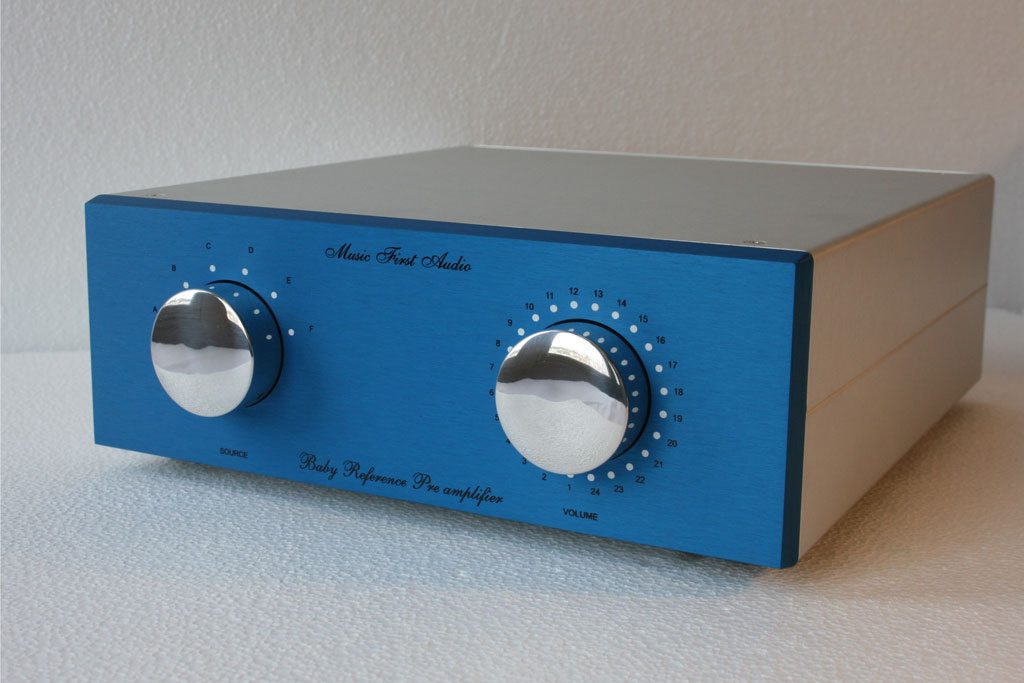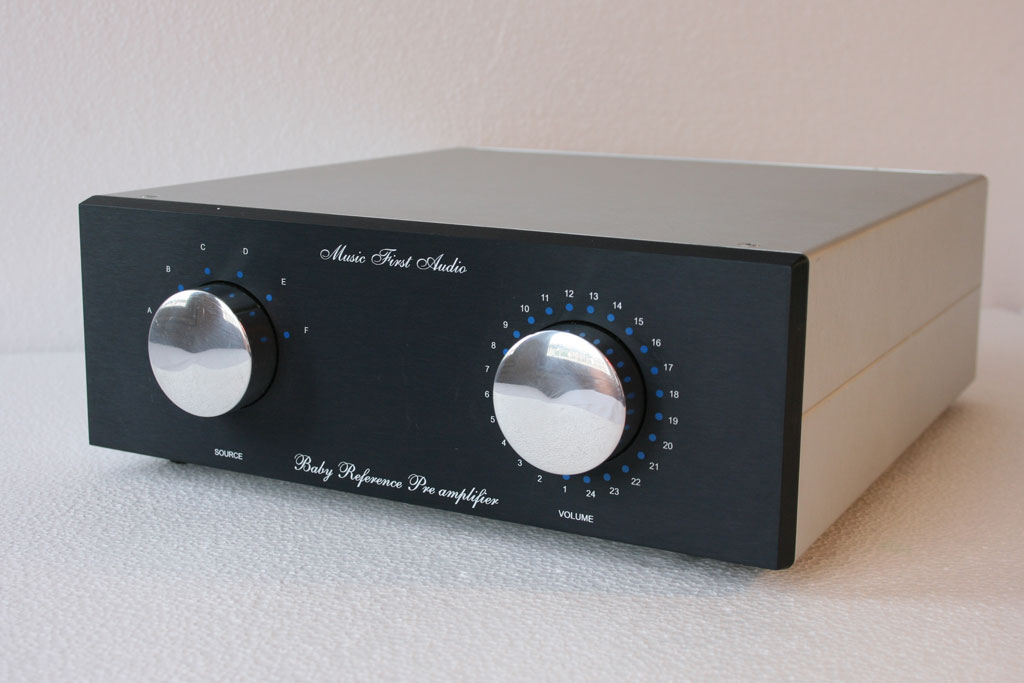Clearing Electronic Haze
A novice audiophile who sets up a system has no reference point for assessment of the overall character of the system’s sound. The system may lack in terms of purity of sound, but the listener will not realize it. The more equipment the listener is exposed to in that system it becomes obvious that some pieces of equipment are able to “get out of the way” or seem more acoustically transparent than others. Just as flying into several cities around the world reveals a dramatic difference in local air quality, so also hearing several systems in one’s room reveals substantial differences in “air” quality, that is, the acoustic air one hears. Most combinations of audio components produce “electronic smog,” but it is not readily noticed until with the replacement of a component it is lessened. The Baby Reference, when inserted into a rig, typically lessens the “smog” and conversely is a refreshing experience.
The timbral accuracy of the Baby Reference is superb. When assessing review products I listen carefully to the contribution of each instrument, each distinct note, in order to sense whether it evokes the reaction which signals to the mind that the performance is being heard live. Most amps can get some of these signals correct, but the Baby Reference gets nearly everything correct. Considering Seal’s Soul 2, nuances in “Love Don’t Live Hear Anymore,” manifest themselves readily. Every “ting” of the cymbal, every synthesized low-level boom in the background sits in juxtaposition to the whole. One of the signs that the Baby Reference is able to create a convincing portrayal of a performance is that even synthesized notes take on a quasi-acoustic instrument nature, transformed from flat notes to rounded notes.
Dynamics and Soundstaging
To see how convincingly a preamp sets up a soundstage I use Peter White’s disc Good Day and the track “Mission to Mars.” Electronic music can be excellent for fleshing out how wide and deep a system can throw an acoustic clue, how far afield the field can get, so to speak. The intro of this piece contains ambient verbal and non-verbal clues floating in a seeming outer space environment. Radio communications pop in and out from the background as if connecting over long distances. Active preamps have typically resolved the voices along the lines of chipmunk-like chatter, as if the content of the conversation is negligible. When the Baby Reference was inserted into the system these conversations took on a human context, as though flesh and blood were conveying pre-launch information. This drew me in as though anticipating an event, embarking on an adventure.
When the thrumming bass line commenced I perceived an attempt on Peter’s part to mimic a heartbeat, as though a stethoscope had been wired to the sound effects board in the recording studio. In others words, the Baby Reference has the capacity to touch the spirit inside of the listener and give it a “wake up” shake!
High End Energy
Insertion of the Baby Reference could bring increased high-end intensity, or at least more delineation of Treble. This can cause some audiophiles distress, as though the system has become too defined; for them a mellow, even if less distinct, result is preferable. This can be addressed by power, interconnect and speaker cabling. Even the use of custom Opamps in the Eastern Electric Minimax DAC Plus has a pronounced influence in this respect.
My friend, Chris, who plays trumpet and listens to artists like Freddy Hubbard and Miles Davis, is quite particular about this instrument as heard on an audio system. At the time he visited I had the Daedalus Ulysses, one of the more smooth and laid back speakers I have reviewed, in the system. Hubbard’s and Davis’s trumpets did not have enough bite, enough distinction of leading edges of notes, even though the Treble setting on the Ulysses was at +2dB.
Knowing that even a single change of a cable or opamp causes a sea change in the character of the system, I removed the Burson discrete opamps from the Minimax and replaced them with the DEXA NewClassD equivalents. Continuing listening to these trumpet legends Chris’s physical disposition changed markedly; he began to sway, his hand reflexively moving as if depressing the valves of a trumpet! His reaction was, “Yeah, now this is good!” He could not get over how the recording had been vitalized by a five-minute change of opamps. The Baby Reference is so revealing, so transparent that the smallest of system adjustments are fully rendered. Because there is no electronic haze a rig can be repositioned to one’s taste readily.
Two Kinds of Audiophiles
Among the many dichotomies in audio exists that of the person who whittles down the electronics in the signal path versus the person who places any number of devices in the signal path in an effort to massage the sound into a pleasing form. Each hobbyist needs to determine which path they will pursue.
The Baby Reference is a minimalist system product, and although not inexpensive represents a cost-no-object design in terms of the signal path to put the music first. It competes handily with preamps costing multiples more. Though I would love for it to come at a bargain price, I realize that quality costs and extreme quality costs plenty.
My guess is that if you buy the Baby Reference to compare with your pricey active preamp once the TVC is placed into the rig likely the preamp will sit collecting dust. There is such variance in the sound quality of active preamps, much less pricing variance, that the enthusiast would be well served to dump the lot of them, taking a Baby Reference and contouring the system around it.
Associated Components:
- Source: Musical Fidelity M1CDT Transport; Sonos Digital Music System; Oppo DV-970HD
- NAS: Buffalo Linkstation 500G
- DAC: Eastern Electric Minimax DAC Plus with Burson and Dexa NewClassD Discrete Opamp Upgrade; Musical Fidelity V90-DAC
- Preamp: VAC Renaissance Signature Preamplifier MkII; Pass Labs XP-20; Cambridge Audio 840E
- Amps: VAC Phi 200; Pass Labs X600.5 Monos; Musical Fidelity M1PWR (two units bridged to Mono)
- Integrated: Pathos Classic One MkIII stereo tube hybrid (two units bridged to mono); Peachtree Audio Nova
- Speakers: Kings Audio Kingsound King III; Legacy Audio DSW Clarity Edition; Kings Audio King Tower omnidirectional; Daedalus Audio Ulysses used in Landscape orientation; Vapor Audio Nimbus White
- Subwoofers: Legacy Audio XTREME HD (2)
- IC’s: Clarity Cable Organic RCA/XLR; Tara Labs RSC Air1 series 2; Wireworld Equinox; Wireworld Silver Eclipse; Wireworld Platinum Eclipse; Snake River Audio Signature Series Interconnects; Silent Source “The Music Reference”
- Speaker Cables: Clarity Cable Organic Speaker; Tara Labs RSC Air1; Wireworld Equinox 5; Wireworld Silver Eclipse; Snake River Audio Signature Series Speaker Cables; Silent Source “The Music Reference”
- Digital Cables: Clarity Cable Organic Digital; Tara Labs RSC Air 75; Wire World Startlight 6; Wireworld Gold Starlight 5, Wireworld Gold Starlight 6; Snake River Audio Boomslang; Silent Source “The Music Reference”
- Power Cables: Clarity Cable Vortex; MIT Oracle ZIII; Tara Labs RSC Air; Xindak PF-Gold; Wireworld Stratus 5, Electra 5 and Silver Electra; Snake River Audio Signature Series; Silent Source “The Music Reference”
- Power Conditioning: Wireworld Matrix Power Cord Extender; Tara Labs ISM Power Screen; Tice Audio Solo
- ← Previous page
- (Page 3 of 3)


